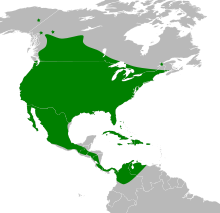**Taxonomy and Distribution:**
– Big brown bat (Eptesicus fuscus) described in 1796 by Palisot de Beauvois.
– Genus name possibly derived from Greek for ‘able to fly’ or ‘house flier’.
– Species name ‘fuscus’ means brown in Latin.
– Type species for the genus Eptesicus, with 11-12 recognized subspecies.
– Widely distributed in North America, the Caribbean, and parts of South America.
– Found in various habitats like douglas-fir forests and urban parks.
– Related species include E. anatolicus and E. serotinus.
**Behavior and Ecology:**
– Big brown bats use echolocation for navigation.
– Modulate pulse intervals to overcome range ambiguity in cluttered surroundings.
– Males and females exhibit differences in habitat use.
– Roost selection based on diet and safety factors.
– Maternity colony bats display specific feeding behaviors.
**Health and Diseases:**
– Resistant to white-nose syndrome.
– Susceptible to rabies virus infections.
– Studies conducted on rabies prevalence in wild-caught bats.
– Research on regional blood distribution during torpor and arousal.
– Experimental infections with rabies virus in big brown bats.
**Conservation and Management:**
– Efforts include building bat houses for conservation.
– Standards and medical management guidelines for captive insectivorous bats.
– Monitoring national surveillance trends for rabies among bats.
– Surveys for West Nile virus in bats.
– Conservation actions aim to protect this abundant species.
**Physiology and Adaptations:**
– Possess brown fat aiding in thermogenesis.
– Studies on morphology and function of pubic nipples in bats.
– Research on thermogenic effect during arousal from hibernation.
– Presence of DDE in brown and white fat of hibernating bats.
– Adaptations like thick ears and specific physiological responses observed.
The big brown bat (Eptesicus fuscus) is a species of vesper bat distributed widely throughout North America, the Caribbean, and the northern portion of South America. It was first described as a species in 1796. Compared to other microbats, the big brown bat is relatively large, weighing 15–26 g (0.53–0.92 oz) and possessing a wingspan of 32.5–35 cm (12.8–13.8 in).
| Big brown bat | |
|---|---|

| |
| A big brown bat on a rock | |
| Scientific classification | |
| Domain: | Eukaryota |
| Kingdom: | Animalia |
| Phylum: | Chordata |
| Class: | Mammalia |
| Order: | Chiroptera |
| Family: | Vespertilionidae |
| Genus: | Eptesicus |
| Species: | E. fuscus
|
| Binomial name | |
| Eptesicus fuscus (Beauvois, 1796)
| |

| |
| Range map | |
| Synonyms | |
| |
Big brown bats are insectivorous, consuming a diverse array of insects, particularly night-flying insects, but especially beetles. Some of the beetles it consumes are serious agricultural pests, including cucumber beetles. They are nocturnal, foraging for prey at night and roosting in sheltered areas during the day such as caves, tunnels, tree cavities, and human structures. Their breeding season is in the fall, shortly before their annual hibernation. After hibernation ends in the spring, females form maternity colonies for giving birth to young. Oftentimes only one offspring is produced per litter, though twins are common in the Eastern US. Lifespans of 6.5 years are considered average.
The big brown bat occurs widely throughout the US, Canada, Central America, and the Caribbean. Its range extends into parts of South America, found as far south as Colombia and Venezuela. It is adaptable to many habitats and is considered a generalist species. The big brown bat is not considered at risk for extinction, and is evaluated as the lowest conservation priority by the International Union for Conservation of Nature (IUCN).
While some other bat species in its range have experienced dramatic population declines due to the fungal disease white-nose syndrome, the big brown bat is relatively resistant to the effects of the disease, and some populations have even increased since the syndrome arrived in North America. Like all bats in the US, the big brown bat can be impacted by rabies, though some individuals have immunity against the virus. Even though sick bats are more likely to be submitted for testing, in 2011, only 3.8% of submitted big brown bats were positive for the rabies virus. Bat boxes are sometimes used to attract them as they are an agriculturally valuable species.

